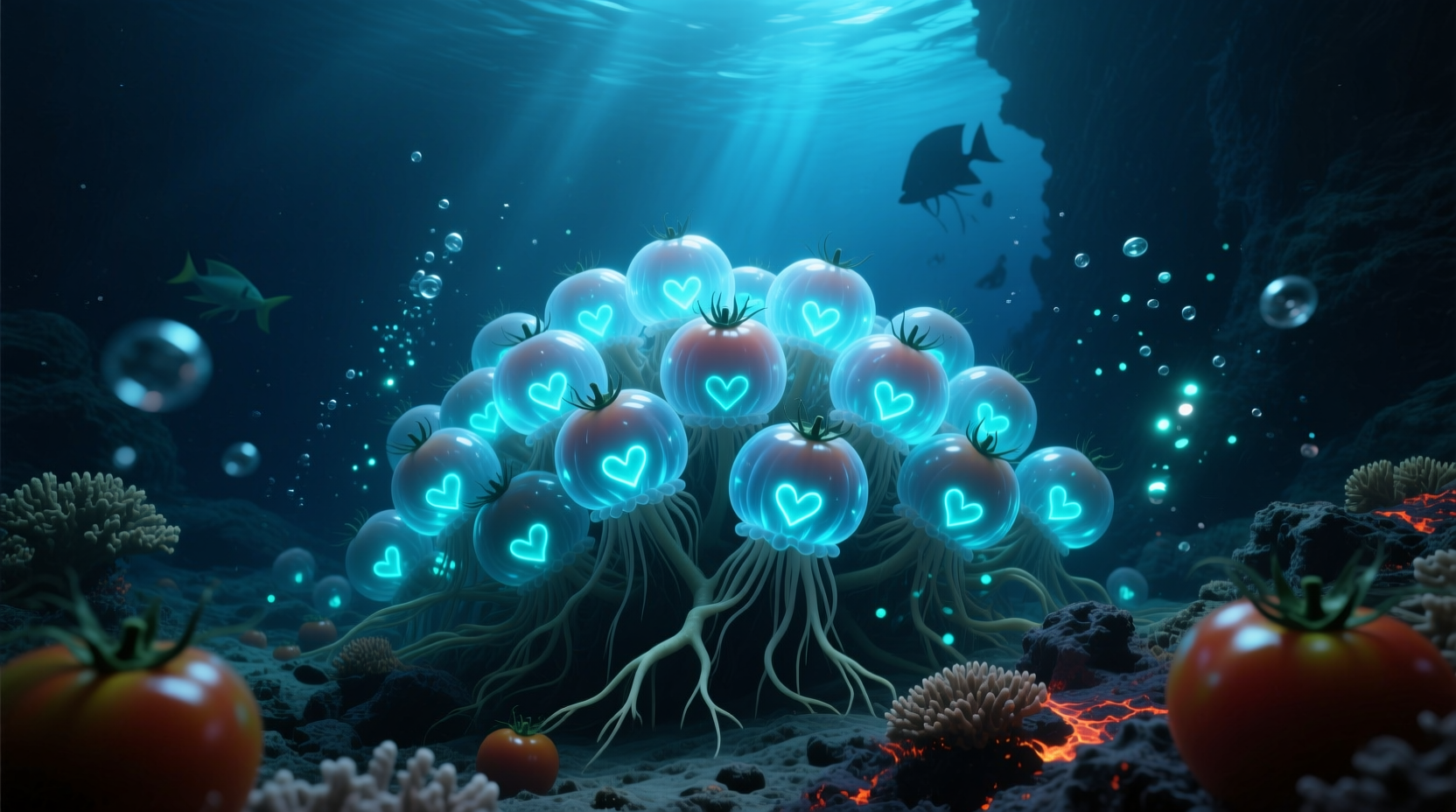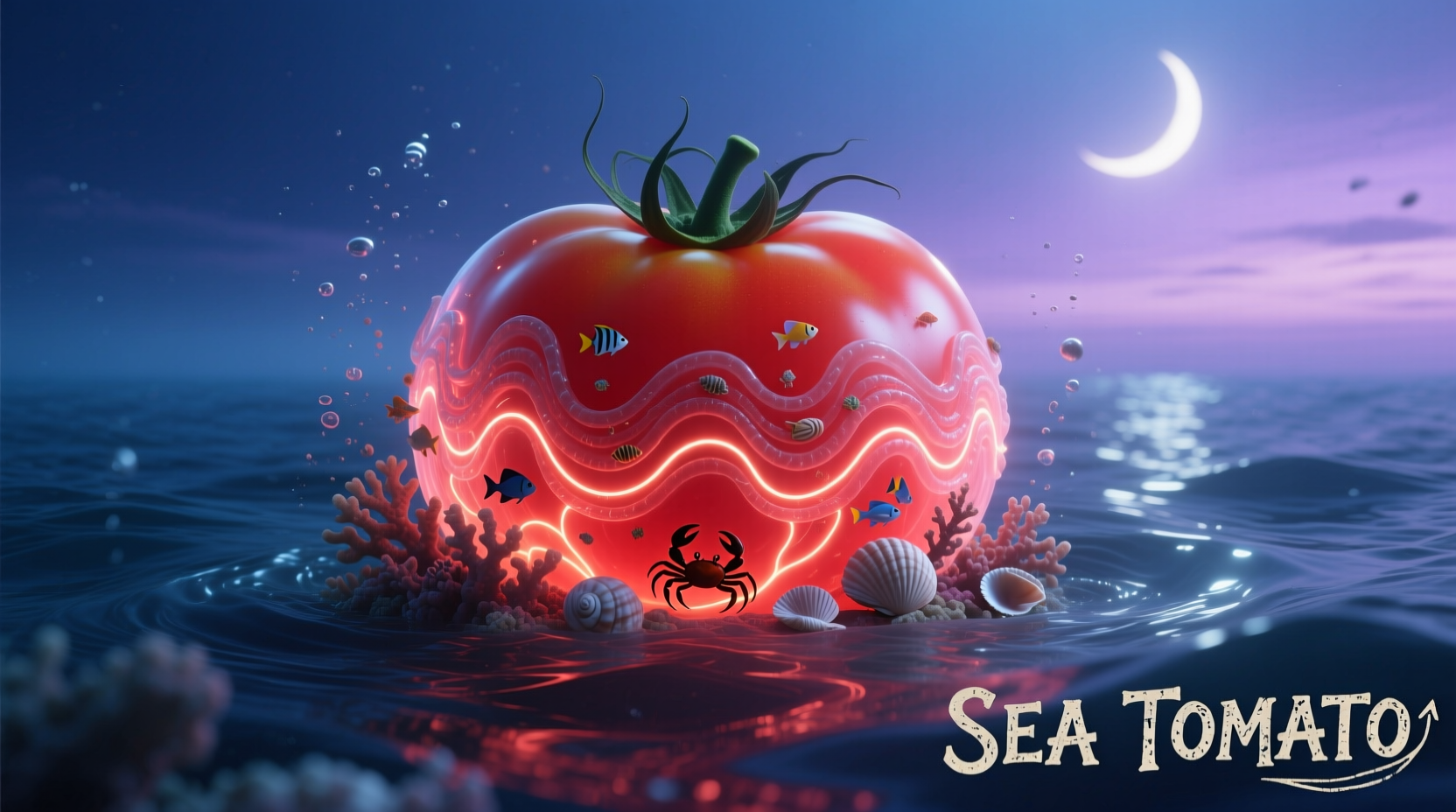Confused by the name "sea tomato"? You're not alone. This misleading term describes Pyrosoma atlanticum, a free-floating colonial organism that's captured public imagination through viral ocean footage. Understanding what sea tomatoes truly are—and aren't—begins with correcting a widespread misconception that has persisted for decades.
What Sea Tomatoes Actually Are (And Why the Name Is Wrong)
The term "sea tomato" creates immediate confusion because these organisms share no biological relationship with Solanum lycopersicum, the common tomato. Instead, sea tomatoes represent Pyrosoma atlanticum, a species of tunicate belonging to the class Thaliacea. These colonial animals form cylindrical structures that can reach up to 60 centimeters in length, with individual zooids (organisms) working together as a single functional unit.
| Characteristic | Sea Tomato (Pyrosoma atlanticum) | True Tomato (Solanum lycopersicum) |
|---|---|---|
| Biological Classification | Marine animal (Chordata phylum) | Land plant (Solanaceae family) |
| Edibility | Not edible for humans | Commonly consumed |
| Structure | Colonial zooids forming tubes | Fleshy fruit with seeds |
| Habitat | Ocean waters worldwide | Grown on land |
| Notable Feature | Bioluminescent properties | Rich in lycopene |
The misnomer likely originated from their reddish-pink coloration and cylindrical shape, which vaguely resembles certain tomato varieties when viewed superficially. However, this comparison ends at visual appearance—biologically, they exist in completely different kingdoms of life.
Bioluminescent Wonders of the Deep
One of the most remarkable features of Pyrosoma atlanticum is their natural bioluminescence. When disturbed, these colonies emit a bright blue-green light through a chemical reaction involving luciferin and luciferase enzymes. This phenomenon, documented by NOAA's Ocean Exploration Program, serves as both a defense mechanism and communication tool among colonies.
Each individual zooid in the colony functions as both filter feeder and propulsion system. They draw water through their bodies to capture plankton, then expel it to move the entire colony forward. This coordinated movement creates a gentle pulsing effect that's particularly visible when the organisms are bioluminescent.

Where Sea Tomatoes Thrive: Habitat and Distribution
Pyrosoma atlanticum inhabits temperate and tropical oceans worldwide, typically found at depths between 10-500 meters. According to research published in the Journal of Plankton Research, these organisms demonstrate seasonal migration patterns, moving closer to the surface during nighttime hours.
Recent observations have noted unusual population increases along the Pacific Northwest coast. The NOAA Pacific Marine Environmental Laboratory has documented significant blooms of Pyrosoma atlanticum in regions where they were previously rare, potentially linked to changing ocean temperatures and currents.
Ecological Significance and Recent Changes
As filter feeders, sea tomatoes play an important role in marine ecosystems by consuming phytoplankton and serving as food for larger predators including sea turtles and certain fish species. Their sudden population increases in unexpected regions have raised scientific interest.
A 2022 study by the University of Washington's School of Aquatic and Fishery Sciences tracked Pyrosoma atlanticum blooms along the Washington and Oregon coasts, noting a correlation between warmer water temperatures and increased colony formation. This research suggests these organisms may serve as indicators of changing ocean conditions.
Can You Eat Sea Tomatoes? Safety and Misconceptions
Despite the "tomato" in their common name, sea tomatoes are not edible for humans. Unlike actual sea vegetables like nori or dulse, Pyrosoma atlanticum lacks nutritional value for human consumption and may cause digestive discomfort if ingested.
The confusion likely stems from similar-sounding edible marine plants:
- Sea grapes (Caulerpa lentillifera) – edible algae consumed in Asian cuisine
- Sea beans (Salicornia) – edible halophyte plants
- Sea cucumbers – echinoderms sometimes consumed in Asian dishes
None of these are related to Pyrosoma atlanticum, and attempting to consume sea tomatoes could lead to unpleasant experiences due to their gelatinous, non-nutritive composition.
Why Sea Tomato Sightings Are Increasing
Over the past decade, reports of sea tomato sightings have grown more frequent, particularly along North America's western coastline. This trend appears connected to broader oceanographic changes:
- Warming ocean temperatures creating more favorable conditions
- Changing current patterns transporting colonies to new regions
- Reduced competition from other plankton-consuming organisms
Marine researchers encourage citizen scientists to document sightings through platforms like iNaturalist, helping track these organisms' expanding range. However, they caution against handling them directly, as the mucus they produce can irritate sensitive skin.
Appreciating Sea Tomatoes Safely
While you shouldn't attempt to harvest or consume sea tomatoes, you can appreciate these fascinating organisms through:
- Guided night kayaking tours in areas where they're commonly sighted
- Marine research facility exhibits (some aquariums feature bioluminescent displays)
- Citizen science initiatives documenting their presence
Remember that these delicate organisms play important roles in ocean ecosystems. When observing them in the wild, maintain a respectful distance and avoid disturbing their natural behavior patterns.
Frequently Asked Questions
Are sea tomatoes actually related to tomatoes?
No, sea tomatoes (Pyrosoma atlanticum) share no biological relationship with actual tomatoes. They're marine animals in the tunicate family, while tomatoes are flowering plants. The name comes only from their superficial visual resemblance to certain tomato varieties.
Can sea tomatoes hurt humans?
Sea tomatoes pose no direct threat to humans. They lack stinging cells or venom. However, their mucus coating may cause minor skin irritation in sensitive individuals, and they're not edible. The primary risk comes from confusing them with actual edible sea vegetables.
Where can I see sea tomatoes in the wild?
Sea tomatoes appear worldwide in temperate and tropical oceans. Recent sightings have increased along the Pacific Northwest coast (Washington, Oregon, British Columbia), particularly during warmer months. Nighttime ocean excursions offer the best chance to witness their bioluminescence.
Why do sea tomatoes glow in the dark?
Sea tomatoes produce bioluminescence through a chemical reaction involving luciferin and luciferase enzymes. This light emission serves as both a defense mechanism (startling predators) and communication method between zooids in the colony. The light can travel through the entire colony in a wave-like pattern.
Are sea tomatoes dangerous to marine ecosystems?
While sea tomatoes play natural roles in marine food webs, unusually large blooms may indicate ecosystem changes. In massive quantities, they could potentially compete with other filter feeders for plankton resources. Researchers are studying whether their recent population increases represent temporary fluctuations or longer-term shifts in ocean conditions.











 浙公网安备
33010002000092号
浙公网安备
33010002000092号 浙B2-20120091-4
浙B2-20120091-4